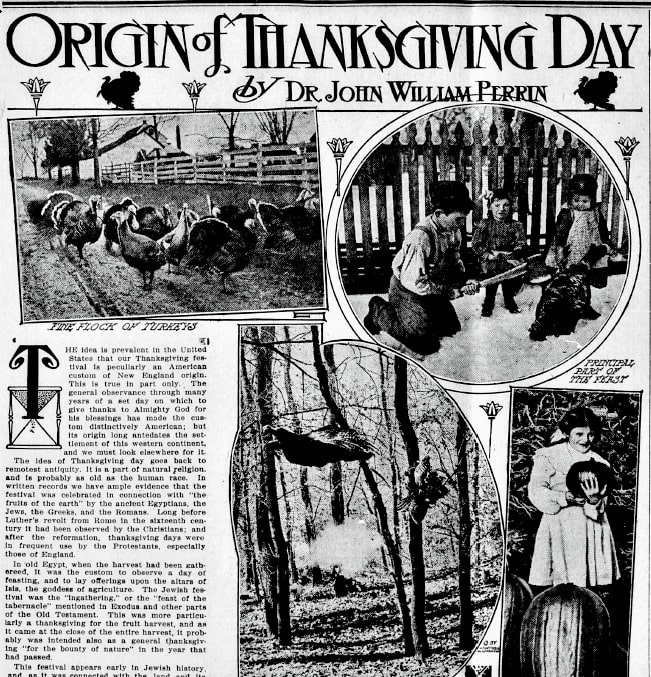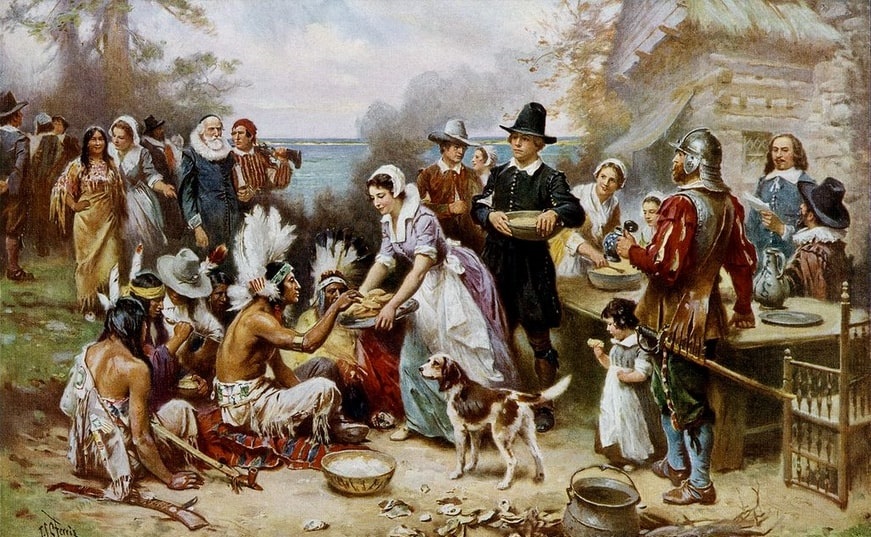Introduction: In this article, Melissa Davenport Berry writes about the origins of the Pilgrims’ first Thanksgiving in America. Melissa is a genealogist who has a blog, AnceStory Archives, and a Facebook group, New England Family Genealogy and History.
For your feasting pleasure this holiday: tasty tidbits on the origin of Thanksgiving by Dr. John William Perrin, published in the Morris County Chronicle in 1912.

As Dr. Perrin wrote:
“The idea is prevalent in the United States that our Thanksgiving festival is peculiarly an American custom of New England origin. This is true in part only.”
In fact, the genesis of a harvest celebration of thanks goes back to the remotest antiquity. I will cite a few examples from Perrin and then dish up America’s first Thanksgiving as ordered by Governor Bradford.
From early on Greeks, Romans, Egyptians, and the Jews held many feasts, banquets, and festivals to honor the fruits of labor, a bountiful harvest, and pay homage to the gods. The English Protestants partied hard in giving thanks. When Henry V had his great victory at Agincourt in 1415, a public thanksgiving was held. When Queen Elizabeth I had her victory over the invincible Spanish Armada in 1588, the whole realm gave thanks in psalms, singing, and dancing.
Dr. Perrin wrote:
“The prototype of our present Thanksgiving day is found in the harvest festival at Plymouth in 1621. The long winter that followed the establishment of the colony had been one of great mortality and suffering. Scarcely half of the colony had survived it. In the spring and summer that followed [in 1621] their fortunes improved, and by autumn they had cleared twenty-six acres and made it ready for cultivation. This industry, too, had been rewarded by a bounteous harvest. Now food and fuel sufficient for the needs of the approaching winter were laid in. Then Governor Bradford ordered a Thanksgiving – the first in America.”
It was not just one day, but continued a week.

Edward Winslow wrote to a friend in England:
“Our harvest being gotten in, our governor sent four men on fowling so we might after special manner rejoice together after we had gathered the fruits of our labors. They four killed as much fowl as with a little help beside served the company about a week. At which times, among other recreations, we exercised our arms, many of the Indians coming amongst us, and among the rest their greatest king, Massasoyt, with some ninety men, whom for three days we entertained and feasted, and they went out and killed five deer, which they brought and bestowed on our governor and upon the captains and others.”
Dr. Perrin wrote that the Pilgrims did more than feast; they played, too:
“From other sources we know that there were athletic contests besides the exercises of arms [shooting of guns] which Winslow mentioned. No doubt they played at ‘stoolball,’ an old form of croquet, and ‘pitch ye bar,’ which Bradford mentions in his journal.”
Nathaniel Philbrick in Mayflower: A Story of Courage, Community, and War, asserts that by all rights none of the Pilgrims should have emerged from the first winter alive:
“That it had worked out differently was a testament not only to the Pilgrims’ grit, resolve, and faith, but to their ability to take advantage of an extraordinary opportunity. During the winter of 1621, the survival of the English settlement had been in the balance. Massasoit’s decision to offer them assistance had saved the Pilgrims’ lives in the short term. Placing their faith in God, the Pilgrims might have insisted on a policy of arrogant isolationism. But by becoming an active part of the diplomatic process in southern New England – by sending Winslow and Hopkins to Sowams; by compensating loyalty to the Nausets for the corn; and most important by making clear their loyalty to Massasoit at the ‘hurly-bury’ in Nemasket – they had taken charge of their own destiny in the region.”
Philbrick noted that the two different peoples with profound differences – the Pilgrims and the Pokanokets – had more in common than generally appreciated today. When the two joined to eat and drink on that first Thanksgiving, they merged as human beings in kinship and spirit to celebrate a common purpose and give thanks.
Happy Thanksgiving!

Melissa, as an Alden descendant I like this take on things… job well done. I can’t get the Facebook group “New England Family Genealogy and History” to work. The URL won’t work. Drop me a note some time.
Hi Mike, thank you! I will send you the link to my New England Group; there are lots of Mayflower descendants and activity — you will enjoy it.
One of my take-aways from having read Philbrick’s book mentioned above was that I had not known that the Pilgrims actually didn’t steal land from the Native Americans, they purchased it. And, following that practice, even our federal government later on purchased many territories of land across this continent from others who had held it as theirs by conquest. And when we did conquer in the war with the Mexicans, we compensated them by, in a sense, purchasing it with $15M in gold. There is a record of those territories acquired over the years at the Wikipedia site.
Julia, thanks for sharing. I found records of the later transactions in GenealogyBank newspaper searches and there are many articles as well. Philbrick’s book is excellent and very informative. Stay tuned for more Mayflower stories too!